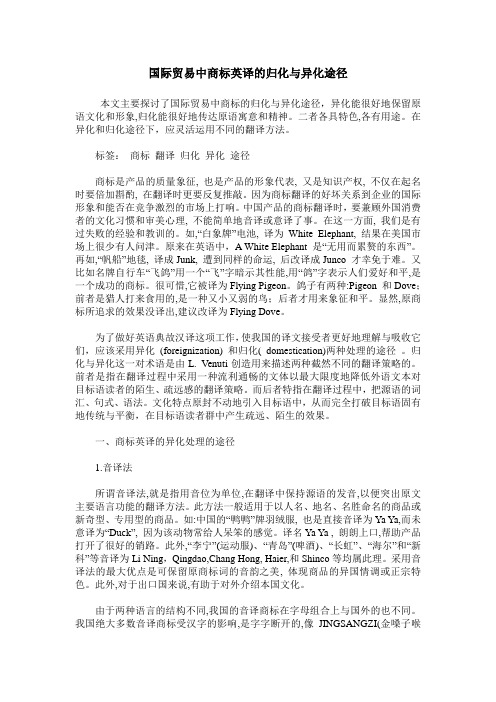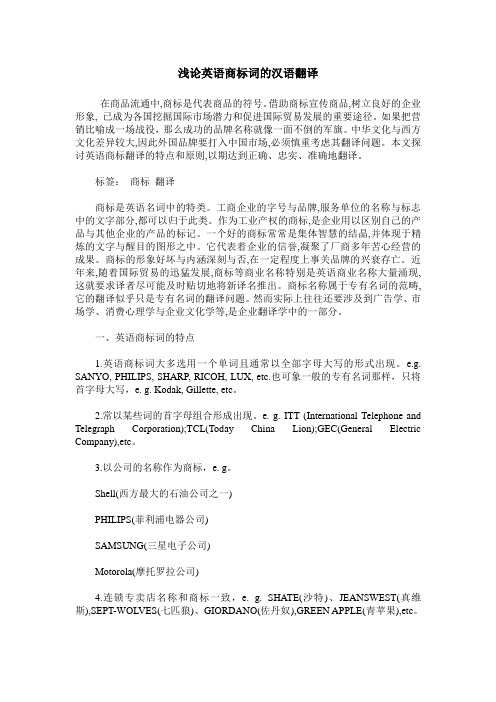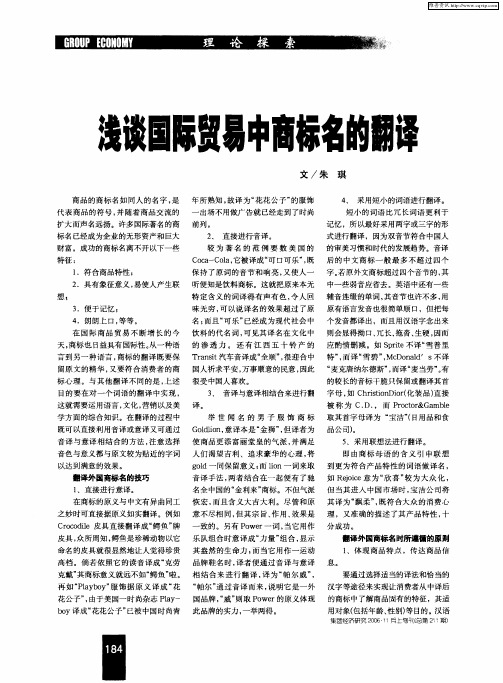浅谈国际贸易中商标的翻译
浅谈商标的翻译

浅谈商标的翻译摘要:商标就是商品的标识,它是一个名称,符号或者一种设计,商标代表该企业在其产品上使用并受法律保护,其他企业不能使用用。
随着经济全球化和全球商贸的发展,商标作为架设在商品和消费者之间的桥梁,在国际贸易中扮演着越来越重要的角色.因此商标的翻译对于企业在国际市场中商品的销售起着举足轻重的作用。
本文从商标的定义和重要性入手,分析了商标的功能及特点,并且在此基础上总结了商标翻译的特点、原则、主要的翻译方法及其中存在的文化差异。
关键词:商标翻译; 原则; 文化差异浅谈商标的文本体现与翻译问题一、品牌和商标概述商标俗称为“牌子”,其实质是一个名称,符号或设计,它代表该企业在其产品上使用并受法律保护,其他企业不能使用用。
是指商品生产者或经营者为使自己的商品在市场上同其他商品生产者或经营者的商品相区别,而使用于商品或其包装上的,由文字、图形或文字、图形的组合所构成的一种标记。
我国加入WTO之后,在我国经济改革的刺激下,各种产品的进口或出口量飞速增长。
然而,在当今的国际商业环境,竞争是普遍的。
为了更具竞争力,企业应采取适当的和有吸引力的商标。
因此,在国际贸易中品牌和商标的翻译正在发挥越来越重要的作用。
美国经济学家R •海斯指出,商标是一个品牌一个名称,术语,标志,符号,设计或它们的组合,告诉顾客生产商是谁。
商标是一个品牌名称是品牌的一部分。
商标作为表示商品的一个基本标志,其应足以使一般商品购买人信赖商标而区别商品之来源与品质。
故商标应具有特别性与甄别力,这就是这里所讲的显著性。
“显著性”(或称“识别性”)是商标构成要素之一.对于缺乏识别性的标章,各国商标法均规定其不得申请注册。
而“显著性”在商标法上系属抽象而不确定之法律概念,各国认定标准不一,其宽严亦有差距.并且显著性之有无,并非一成不变,它将随着时间而冲淡或消失,亦可因时间而取得或增长。
随着商标意义的扩展,商标职能也正变得广泛起来。
通常,其职能主要是关于关系生产者和消费者,这将是涉及如下:(1)区分功能:商标的作用是用来确定某一商品制造商,并说明其来源。
国际贸易中商标英译的归化与异化途径

国际贸易中商标英译的归化与异化途径本文主要探讨了国际贸易中商标的归化与异化途径,异化能很好地保留原语文化和形象,归化能很好地传达原语寓意和精神。
二者各具特色,各有用途。
在异化和归化途径下,应灵活运用不同的翻译方法。
标签:商标翻译归化异化途径商标是产品的质量象征, 也是产品的形象代表, 又是知识产权, 不仅在起名时要倍加斟酌, 在翻译时更要反复推敲。
因为商标翻译的好坏关系到企业的国际形象和能否在竞争激烈的市场上打响。
中国产品的商标翻译时,要兼顾外国消费者的文化习惯和审美心理, 不能简单地音译或意译了事。
在这一方面, 我们是有过失败的经验和教训的。
如,“白象牌”电池, 译为White Elephant, 结果在美国市场上很少有人问津。
原来在英语中,A White Elephant 是“无用而累赘的东西”。
再如,“帆船”地毯, 译成Junk, 遭到同样的命运, 后改译成Junco 才幸免于难。
又比如名牌自行车“飞鸽”用一个“飞”字暗示其性能,用“鸽”字表示人们爱好和平,是一个成功的商标。
很可惜,它被译为Flying Pigeon。
鸽子有两种:Pigeon 和Dove;前者是猎人打来食用的,是一种又小又弱的鸟;后者才用来象征和平。
显然,原商标所追求的效果没译出,建议改译为Flying Dove。
为了做好英语典故汉译这项工作,使我国的译文接受者更好地理解与吸收它们,应该采用异化(foreignization) 和归化( domestication)两种处理的途径。
归化与异化这一对术语是由L. Venuti创造用来描述两种截然不同的翻译策略的。
前者是指在翻译过程中采用一种流利通畅的文体以最大限度地降低外语文本对目标语读者的陌生、疏远感的翻译策略。
而后者特指在翻译过程中,把源语的词汇、句式、语法。
文化特点原封不动地引入目标语中,从而完全打破目标语固有地传统与平衡,在目标语读者群中产生疏远、陌生的效果。
一、商标英译的异化处理的途径1.音译法所谓音译法,就是指用音位为单位,在翻译中保持源语的发音,以便突出原文主要语言功能的翻译方法。
国际贸易中的商标翻译

国际贸易中的商标翻译随着经济全球化进程的加快,市场竞争日益激烈,树立良好的商品形象极为重要,因此,除了具有过硬的产品质量、合理的价格、精美的包装外,还要打造知名品牌。
商标trademark就是商品的品牌,是商品生产者或经营者为了使自己的商品同他人的相互区别而使用的一种具有显著特征的标记。
一、商标翻译的原则人们生活水平不断提高,商标就像一面旗帜在引领消费者。
商标已成为打开国际市场的通行证,决定着企业的存亡。
好的商标翻译就像润滑油,能加速商品的销售并弘扬企业形象。
好的商标要让消费者一眼看见就能记住其名称和图案,因此商标的翻译要遵循以下原则:首先,商标翻译要能够反映一个民族的悠久历史和文化。
商标大多数与各自民族历史和文化紧密相连,由于中西方文化差异较大,因此商标词的翻译超越了语言学概念。
王佐良先生曾说:“翻译最大的困难是两种文化的不同”。
优质的翻译不但要求译者思路灵活、知识丰富、善于联想、更要有深刻敏感的文化意识,采用当地人喜好的商品名称,避免采用忌讳的或容易产生误会和反感的词语,只有这样才能充分有效地传递其内涵,从而促进商标的宣传作用。
中国人几千年来深受佛教、道教等的影响,崇尚富足、健康、吉祥。
Goldlion 若按其发音译为“金狮”,与广东方言“金失”同音,而“金利来”,寓意“财源滚滚”备受中国消费者的喜爱。
又如带有吉利的字眼的Konka“康佳”,Jetta “捷达”,Cannon“佳能”,7-up饮料“七喜”等。
同时,东方人比较注重居家的温情和安宁。
如,Safeguard(“舒肤佳”香皂)保护你的皮肤光洁细嫩,Tide(“汰渍”洗衣粉)轻易洗去污渍,Whisper(“护舒宝”卫生巾),“嘘,别出声”,Pampers(“帮宝适”尿布)双亲的舐犊之情由然而生,极富人情味。
另外,女性用品市场是消费品最大市场,翻译时应注意迎合女性审美情趣,如“芳”、“婷”、“丝”等字眼:Avon(雅芳)、Pantene(潘婷)、Tampax(丹碧丝)。
浅论英语商标词的汉语翻译

浅论英语商标词的汉语翻译在商品流通中,商标是代表商品的符号。
借助商标宣传商品,树立良好的企业形象, 已成为各国挖掘国际市场潜力和促进国际贸易发展的重要途径。
如果把营销比喻成一场战役,那么成功的品牌名称就像一面不倒的军旗。
中华文化与西方文化差异较大,因此外国品牌要打入中国市场,必须慎重考虑其翻译问题。
本文探讨英语商标翻译的特点和原则,以期达到正确、忠实、准确地翻译。
标签:商标翻译商标是英语名词中的特类。
工商企业的字号与品牌,服务单位的名称与标志中的文字部分,都可以归于此类。
作为工业产权的商标,是企业用以区别自己的产品与其他企业的产品的标记。
一个好的商标常常是集体智慧的结晶,并体现于精炼的文字与醒目的图形之中。
它代表着企业的信誉,凝聚了厂商多年苦心经营的成果。
商标的形象好坏与内涵深刻与否,在一定程度上事关品牌的兴衰存亡。
近年来,随着国际贸易的迅猛发展,商标等商业名称特别是英语商业名称大量涌现,这就要求译者尽可能及时贴切地将新译名推出。
商标名称属于专有名词的范畴,它的翻译似乎只是专有名词的翻译问题。
然而实际上往往还要涉及到广告学、市场学、消费心理学与企业文化学等,是企业翻译学中的一部分。
一、英语商标词的特点1.英语商标词大多选用一个单词且通常以全部字母大写的形式出现。
e.g. SANYO, PHILIPS, SHARP, RICOH, LUX, etc.也可象一般的专有名词那样,只将首字母大写,e. g. Kodak, Gillette, etc。
2.常以某些词的首字母组合形成出现。
e. g. ITT (International Telephone and Telegraph Corporation);TCL(Today China Lion);GEC(General Electric Company),etc。
3.以公司的名称作为商标,e. g。
Shell(西方最大的石油公司之一)PHILIPS(菲利浦电器公司)SAMSUNG(三星电子公司)Motorola(摩托罗拉公司)4.连锁专卖店名称和商标一致,e. g. SHATE(沙特)、JEANSWEST(真维斯),SEPT-WOLVES(七匹狼)、GIORDANO(佐丹奴),GREEN APPLE(青苹果),etc。
国际贸易中商标翻译方法

国际贸易中商标翻译方法在如今快速发展的全球化经济环境下,国际贸易已经成为国家和企业不可忽视的经济发展模式之一。
在国际贸易中,给商品起一个好的商标能够提高商品的竞争力,进而在市场占据更大份额。
然而,在跨国贸易中,商标的翻译是必不可少的环节。
因此,本文将探讨国际贸易中商标翻译的方法。
一、文字翻译法现如今,一些企业在跨国贸易中为了方便商标的推广,采用文字翻译法来进行商标翻译。
所谓文字翻译法,是将商标原始的汉字翻译成目标国家的语言。
比如“可口可乐”这个商标就是采用了文字翻译法。
这种商标翻译方法的优点是可以让消费者更直观地理解商标含义。
但是,文字翻译法也有一些限制,如果将商标原汁原味地翻译,可能在另一个国家或者文化中丧失了商标的特色。
二、音译法另外一种商标翻译方法是音译法。
音译法是将商标源汉字直接翻译成目标语言当中类似的拼音或者谐音的形式,并借助于目标语言的发音来保留商标的特色。
比如“麦当劳”这个商标就是采用了音译法。
这种方法的优点是可以在目标语言中保留商标的音韵特征和原汁原味的商标名称,但是,如果依赖目标国语言的音韵体系来翻译商标名称,可能会出现歧义或者无法保证商标名称在其他语言当中的文化含义。
三、意译法在跨国贸易中,还有一种商标翻译方法是意译法。
意译法是一种基于语言学和文化学关系来创作新的商标名称的方法。
在此方法中,译者需要理解源汉字商标的含义和文化背景,然后在目标市场中寻找相关的文化符号和象征性物品,将其结合起来来创作符合本地文化和市场需求的新商标名称。
这种商标翻译方法的优点是可以提高商标在目标市场的吸引力和辨识度,并且减少商标在目标市场中可能存在的文化差异。
但是,意译法要求译员有一定的商业敏感性和文化视野。
四、换名法除了以上几种方法之外,还有一种商标翻译方法是换名法。
换名法是指在跨国贸易中拥有一个不一样的商标名称,但是商标的LOGO和装帧样式完全相同。
比如,可口可乐在中国市场中的另一个商标名称是“可口可乐”,这种方法的优点是在保护商标的原有特色的同时,可以根据不同的市场规则和文化习惯来变更商标名称。
浅谈商标的翻译

Abstract
商标是商品和商业服务的标记.它是指商品生产者、经营者、服务提供者为了使自己生产、销售的商品或提供的服务,在市场上与其他商品或服务相区别而使用的一种标记。
它是一种
特殊的语言符号,是商品显着特征的浓缩,是商品文化的核心部分,是企业参与国际竞争的有力武器。
它既是标识,又是诱饵,最终是要招揽顾客,出售商品。
商标翻译符合符号学的翻译观,是由解码到编码的过程,是两种文化的移植。
好的商标翻译可以给企业带来巨大的财富;反之,糟糕的商标翻译可以让企业损失惨重,所以企业的生死存亡与商标翻译息息相关。
同时商标翻译能够拓宽语言学研究空间,丰富语言学的内涵,促进语言理论研究与实际应用的有机结合。
Introduction
随着全球经济一体化的发展和中国改革开放的深入,越来越多的中国企业走向国际市场。
他们日益认识到商标极其商标的翻译对于刺激消费、开拓市场的重要性。
可以毫不夸张的说,商标极其翻译极大的影响着消费者对其产品的态度和消费力度。
浅谈商标翻译方法及原则

浅谈商标翻译方法及原则学科教育?凰留学曰2007耳5月浅谈商标翻译方法及原则曹星月(中国地质大学外国语学院湖北武汉)【摘要】商标是商品的一部分也是产品生产商的无形资产.为了保持并发挥这种无形资产,翻译商标时译者不仅要有语言,文化,知识等方面的综合能力,还且要具备想象力和再创造力,本文各从三个方面论述了商标的翻译方法和翻译原则,强调商标的翻译不在形式,而是有效的传达意思.【关键词】商标翻译方法原则商标在国际贸易中扮演着越来越重要的角色,商标(TradeMark)是企业形象战略(CompanyImageStrategy)的重要组成部分,是商品进入他国市场的重要桥梁.根据美国经济学家R海斯的观点.Abrand,i.e.trademark,isaname,term,sign,sym—bol,designoracombinationofthemthattellswhomakesitorwhosellsit,distinguishingthatproductfromthosemadeorsoldbyoth—er$.Abrandnameisthatpartofbrandthatcanbevocalized.商标在产品的销售中起着重要的广告作用.驰名商标在消费者的心目中是可靠的质量和优质的产品,就是合理的价格和良好的服务.好的商标名寓意深刻,引人注目,以给消费者留下良好的印象.商标的翻译,从一种语言到另一种语言,既要保留原文的精华,又要符合当地消费者的商标心理,这就要求商标的翻译能注重正确有效的翻译方法,同时又要注意文化差异以及消费者心理等诸多问题.笔者就从商标翻译的方法和原则两个方面做一下阐述.1商标翻译的方法1.1音译法音译法是根据商标原文的发音特点,直接选用译入国语言中发音与之相同或相近的文字来将其描述出来.1.1.1音译法一般选择该产品的生产国有该类产品的良好声誉,这种译法的目的语一般不会有什么联想意义.如在世人眼中,英美国家是品质的象征,法国以典雅高贵浪漫闻名,日本以小巧耐用着称,维也纳以音乐为标志.,于是,一些世界品牌产品的商标被直接音译,很好的发挥了名牌效应.如:Motor0l一摩托罗拉(电讯产品),Hi1ton——希尔顿(香烟),casio——卡西欧(电子琴),Aud——奥迪(汽车),sie- mens——西门子(电器),sony——索尼(电器),PierreCardin皮尔卡丹(服装),Shangri—b——香格里拉(酒店)等这种音译法简单易行,既可保留原文的风韵之美,又可表明商品的异国情调,起到吸引消费者注意的作用.1.1.2此类音译的明显特征是既与原商标读音相似,又对照以描写商品的优异性能,引起消费者对该产品的美好联想,从而有买该产品的愿望.这种译法显然更胜一筹,是众商家更希望达到的效果.这里也有不少这样的译作:Madb0m——万宝路(香烟),Benz——奔驰(轿车),Good-y删一固特异(轮胎),co1gate——高露洁(牙膏),safe- gtlard——舒服佳(香皂),tide——汰渍洗(衣粉),pampers——帮宝舒(尿布),Le——利威(牛仔裤),Buler一宝来(钟表)还有一个经典的例子:Pepsi—cola饮料中的Pepsi是专门术语Pepsin(胃蛋白酶)的变体词,暗示这种饮料有"助消化"之功能,而翻译成中文就叫百事可乐,任谁听了都高兴.1.2意译法意译法是根据商标原文的含义,直接选用译入语中与之相对应的词语表达出来.这种译法一般用在源语言本身就有很美好的意思,这个时候按照商标本身的意义翻译过来也不失为一件好事.如:Camel——骆驼(香烟),cr0wn——皇冠(轿车),Pan-da——熊猫(电视),猴王(茶)——MonkeyKing,ballade——抒情诗(化妆品),Ambush——十面埋伏(香水),小护士——Minin? urse.还有将energize牌电池译为"劲能"着实让人震撼,使消费者联想到它无穷的能量.,意译法能够很好地体现原商标确立者的用意,并与商标图案保持一致,是商标翻译的重要方法之一.1.3臆造法臆造法是指翻译商标时既不按照商标的意思,也不按照商标的发音,而是一种为了追求专有性和新奇性以适合顾客心理的翻译.有些商标词的翻译完全"违背"翻译规则,使译名与原商标词毫无联系,无规可循,但并不影响其词标功能.这也可称之为再创造,根据各种文化和消费者因素结合产品和商标进行的再创造.这种译法也不无大量的成功例子:Head&shou1d——海飞丝洗发精,Rejoice——飘柔洗发水,Me1atonin——脑白金,Anycal1——三星电器.还有一个很蛊惑人的香烟品牌叫Kent,这个商标词是其产地名,原来译为"肯特",结果中国人中了解这个地方的人不是太多,后改名为健牌香烟,这个名字差不多使购买者忘记"吸烟有害健康"的政府忠告,甚至以为它有利健康.再如美国的Duracell牌电池,其名来自durable(耐用的,持久的)+cell(电池),喻其产品电量充足,工作时间长,可翻译时却不可避免的遇到了麻烦,后来只好改名为"金霸王",既表达出来了原来的蕴意,又符合中国人的思想文化习惯.所以,臆造法无一定之规,主要是在针对消费者的购买欲而另辟溪径.2商标翻译的原则一50—2007年5月殿蹄学曰?学科教育?2.1联系民族文化,发掘联想意义翻译理论家尤金?奈达指出:"对于真正成功的翻译而言,熟悉两种文化甚至比掌握两种语言更重要,因为词语只有在其作用的文化背景中才具有意义."商标是语言文字和民族文化的统一体.商标译者只有站在跨文化交际的角度,准确把握表层文化和深层文化,才能将商品的物质价值转变成抽象的精神价值,并通过精神价值让消费者了解商品的物质价值,实现物质文化和精神文化的交融.而我们翻译一些商标时,往往会误认为英语国家的消费者和我们有着相同的文化,因此我们的翻译经常会导致商标原文意义的丧失甚至误解,这样的商标翻译毫无疑问就是失败的.例如:"孔雀"牌彩色电视机被译为"peacock"colorTV.乍一看没什么不妥,因为在中国孔雀象征着美丽,鲜艳和高贵,这用来形容彩色电视机是非常有感召力的.然而,英语民族通常认为"孔雀"为污秽,猥亵之鸟,会给人带来厄运.孔雀开屏又被认为是自满自傲的表现,因此,英语中就有诸如asproudasapeacock (非常高傲),playthepeacock(炫耀自己)之类的说法.所以当商家为自己这个美丽的商标名得意洋洋时,殊不知国外的消费者正用诧异和不屑的目光注视着他的产品,所以这种忽视民族文化的翻译无疑是失败的.此种例子也是不胜枚举,中国人眼中的红色有喜庆,活泼等内涵,而英语中红色却与色情有关;中国人眼中的吉祥数字6在《圣经》中象征着魔鬼,美国人甚至要求删除"666"的车尾号;中国人眼中的荷花是"出淤泥而不染"的花中君子,而日本人眼中荷花象征着死亡;中国人眼中仙鹤代表着吉祥和美好,而在法国仙鹤是淫妇的代称.......文化心理是一个民族在长期繁衍发展过程中文化积淀而成的心理特称,东西方人由于地域环境,种族渊源,宗教信仰,经济发展等文化背景不同,人们对商品的认知角度,审美情趣,消费观念和心理联想等方面存在着诸多差异,所以我们在翻译时要做的是充分了解目的语的本土文化,做到InRomeasRomando.2.2迎合消费心理,突出产品特征商标的劝购导购作用在于体现商品的个性特色,符合消费心理,激发消费者的购买欲,商标翻译应避免让消费者产生不良联想.例如:我国出口试销美国的"轻身减肥片",原译名为obesity—reducingtablets,在减肥为时尚的美国却一度无人问津.市场调查后才发现出该产品的译名违反了购买者的消费心理.美国人看了药名后产生的联想是次药专为obesepeople(肥胖症者)服用,后来改译为slimmingpills后就打开了销路.译名必须符合商品本身的性质,体现原文中的定位概念.如:Procter&Gamble公司的原译名"宝碱"就不如现在的名称" 宝洁"好,后者充分体现了公司所生产的洗涤,护肤,口腔保健品等属性.又如:美国生产橡胶轮胎的公司Goodyear和Goodrich则分别被译为"固特异"和"固特立",译者将原来的人名改译为能表明产品经久耐用特点的名称,非常新颖而且极有吸引力.此外,由于销售商在生产某种产品时都有比较明确的消费层次和销售对象,因此商标翻译还要瞄准其消费群,译名的发音和用字应尽可能与商品的市场定位及其所面对的消费群体相结合.如:A VON(雅芳),Italina(伊泰莲娜),Vichy(薇姿),Maybelline(美宝莲)等译名都是针对女性,选用了"芳","莲","娜","姿"等女性喜爱的字眼.2.3音节简洁易读,形势表现多样商标翻译最重要的目标就是让广大消费者通过译名"一劳永逸"地记住自己所代表的产品,建立长久深远的销售网络.为此,商标译名就必须朴实规范,简单易记,形象生动.日本的一项调查表明,四个字的名称认知率为11.3%,6个字的为5.96%,7个字的为4.86%,而8个字以上的只有2.88%.很明显,冗长累赘,不易发音的商标次不但引不起人们的购买兴趣,而且人们会因为发音不准而难堪,甚至会因为累赘的商标而怀疑该产品的性能和服务.例如:Head&Shoulder原译为"海伦仙度丝",译名很长又让人不知所云,远没有现译名"海飞丝"生动.世界上最大的电子仪器与小型电脑制造商HewlettPackardCo.在大陆曾长期音译为"休利特一帕卡德"公司,后来逐渐被港台的另一个译名" 惠普"所取代,既简明又给人积极意义的联想,成为该行业的着名品牌.此外,还有快餐店McDonald's用"麦当劳"代替"麦克唐纳",英国名车RollsRoyce用"劳斯莱斯"代替"罗尔斯~罗依斯"等使用更好的译名来促进销售.至于表现手法的多样化,则可借助于名人地名来表达,也可以在语言上运用双关,比喻,象征等修辞手法.例如:"一Ning——(运动服),pearlfiver(钢琴),MonaLisa(陶瓷),leeKum Kee(调味品).还有SpringBamboo(羊绒衫)具有双关含义,一方面它是汉字"春"的英译,另一方面,spring除春天外还有"弹簧,弹性"之意,暗指该牌子的产品质地柔软,舒适有弹性.其实不难看出,商标翻译的方法和原则并不是独立存在的,它们之间都是相辅相承,密不可分的.而且,很多时候翻译的好坏并不是几个条条框框能说清楚的,这些方法和原则只能对我我们进行指导,而我们要在这些理论上进行不断的练习和提高,以便有效准确的传达意思.我国的翻译还处在起步阶段,很多时候都不能对市场上的翻译进行规范,所以我们难免会见到细些莫名其妙甚至稀奇古怪的商标,对于这类现象我们绝对要保持清醒的头脑,更不能盲从,要具自己的鉴别力和批判力.一个商标,寥寥数字,从小处看关系到商品的形象和销售,从大处看,则反映着民族的素质和风貌,因而做好商标的翻译,是我们国家树立起良好的国际风貌,我们责无旁贷.作为译者,要做的就是不断增加语言,文化和背景知识等因素,集创造力和想象力于一身,不断斟酌,采用各种方法,以选择最地道,最突出,最完美的译法.参考文献[1]刘法公.论商标汉英翻译的几个关键问题[J].中国翻译,2003(6).[2]蒋雷.文化差异与商标翻译的语用失误[J].中国科技翻译,2002(3).[3]安亚平.中国名牌产品商标词译名分析及其翻译方法[J].上海科技翻译,2004(4).[4]张新元.文化差异与商标词的翻译[J].信阳师范学院,2001 (3).[5]容世敏.漫谈商标翻译[J].天津外国语.[6]杨柳.商标的翻译及其魅力[J].中国科技翻译,1995(2).[7]腾梅.商标翻译浅谈[J].大学英语,2001(3).[8]潘红.商标翻译要求神似[J].中国翻译,1996(6).。
浅谈国际贸易中商标名的翻译

致的。另有 P we 一词 , o r 当它用作 分 成功 。
皮 具 , 所 周 知 , 鱼 是 珍 稀 动 物 以它 乐队组合时意译 成“ 量” 众 鳄 力 组合 , 显示
翻译外 园商标名 时所遵循的原则
1 、体现 商品特点 ,传达商 品信 要通过选择适 当的译法和恰 当的
命名的皮具就很显然地让人觉得珍贵 其盎然 的生命力 ; 而当它用 作一运动 克戴” 其商标意义就远不如“ 鳄鱼” 。 相 结 合来 进行 翻译 , 为 “ 啦 译 帕尔 威” ,
4 采 用 短 小 的 词语 进 行 翻 译 。 、 短 小 的 词 语 比 冗 长 词 语 更 利 于
出场 不用做广告就 已经走到了时尚
2 直接进行音译。 、
扩大而声名远扬。许多国际著名的商 前 列 。
记 忆 ,所 以最 好 采 用 两 字 或三 字 的形
式进行 翻译 ,因为双音 节符 合中国人
这就需要运 用语言 , 文化 , 营销以及美 译 。
学方面的综合知识 。在翻译的过程中
既可以直接利用音译或意译又可通过 G ll n 意译本是 “ odi , o 金狮” 但译者 为 品公司) , 。 音译与 意译 相结 合的方法 , 注意选择 使 商品更添 富丽 堂皇的气派 , 满足 并 音色与意义都 与原文较为贴近的字词 人 们渴望吉利 、追求豪华 的心理 , 将
标 心 理 。与 其 他 翻 译 不 同 的 是 , 述 很 受 中国 人 喜欢 。 上
的较长的音标干脆只保 留或翻译其首 被 称 为 C. ,而 P o tr a l D. rco&G mbe
目的要在对 一个词语 的翻译 中实 现 ,
3 音译与意译相结合来进行翻 字母 , C r t n ir化 装品) 、 如 h ii Do( so 直接 举 世 闻 名 的 男 子 服 饰 商 标 取 其首 字母译为 “ 洁” 日用品和食 宝 ( 5 、采用联想法进行翻译 。
- 1、下载文档前请自行甄别文档内容的完整性,平台不提供额外的编辑、内容补充、找答案等附加服务。
- 2、"仅部分预览"的文档,不可在线预览部分如存在完整性等问题,可反馈申请退款(可完整预览的文档不适用该条件!)。
- 3、如文档侵犯您的权益,请联系客服反馈,我们会尽快为您处理(人工客服工作时间:9:00-18:30)。
浅谈国际贸易中商标的翻译(1)
商品的商标如同人的名字,是代表商品的符号,并随着商品交流的扩大而声名远扬。
许多国际著名的商标已经成为企业的无形资产和巨大财富。
成功的商标离不开以下一些特征:
1;符合商品特性;
2.具有象征意义,易使人产生联想;
3.便于记忆;
4.朗朗上口,等等。
在国际商品贸易不断增长的今天,商标也日益具有国际性。
从一种语言到另一种语言,商标的翻译既要保留原文的精华,又要符合消费者的商标心理。
与其他翻译不同的是,上述目的要在对一个词语的翻译中实现,这就需要运用语言,营销以及美学方面的综合知识。
在翻译的过程中可通过音译与意译相结合的作法,注意选择音色与意义都与原丈较为贴近的字词以达到满意的效果。
下面从几则成功的译例谈起。
较为著名的范例要数美国的Cocacola,它被译成“可口可乐”,既保持了原词的音节和响亮,又使人-一听便知是饮料商标。
这就把原来本无特定含义的词译得有声有色,令人间味无穷,可以说译名的效果超过了原名;而且“”可乐”已经成为现代社会中饮料的代名词,可见其译名在文化中的渗透力。
再如举世闻名的男子服饰商标Goldlion,意译本是“金狮”,但译者为使商品更添富丽堂皇的气派,并满足人们渴望吉利、追求豪华的心理,将gold一同保留意义;而lion一词来取音译手法,两者结合在一起便有了驰名全中国的“金利来”商标。
不但气派恢宏,而且含义大吉大利。
尽管和原意不尽相同,但其宗旨、作用、效果是一致的。
大家所熟悉的美国运动系列商品Nike。
音标为[’ naiki:],本意是希腊神话中胜利女神的芳名,但若按音译为“奈姬”或是“娜基’’之类,很多中国的消费者便会十分费解,不知其意。
译老在翻译时模仿其音节,并考虑到运动服装应该具有经久耐磨损的特点,将它译成了“耐克”,既有坚固耐穿的含义,又包含了克敌必阻的意思,这样与原意胜利女神也不谋而合。
其他值得列举的例子还有许多,如Truly,前一字取意,后一字取音,译为"信利”; Accord译成“雅确”,是一种手表的商标,前一字取音,后一字取义;以及Fiyta译作是“飞亚达”也是音意结合的典范。
从审美心理上讲,人们一一旦进入节奏感的欣赏或是感知当中,就会产生一种期待的心理。
诸如诗歌中的押韵,文章中的排比,摄影构图中物体的重复等等,都是对这种心理的满足,同时也是使自身富有美感的手段。
事实上,商标的翻译在很大程度上也依赖于这种心理。
译名不仅在字数、音调,平仄上有要求,而且在意义上的要求更高,这决定了译名的成败。
笔者在有限的素材积累中,发现许多译名只注意到一个方面,而忽略了两者的结合与搭配,。
故常显得令人莫名其妙。
Pizza Hut如今译成“必胜客”,在意义上脱离了快餐的味道,在膏色上丧失了中国人对其原有的熟悉与亲切感。
倒不如译成``比萨饼”实在,“比萨”是音译,“饼”用来描述食品的种烫;这样既可表达意大利是该美食的故乡,又能借助比萨斜塔的声名唤起食客对意大利美丽风光的联想。
再比如两个纯粹音译的例子, Sportsman自行车和Unlsports运动鞋,市场上的译名前者为“斯波兹曼”,后者为“纽伦斯堡”,若不是对品脾的熟悉,有谁会把这两个名称与它们所代表的产品联系在一起呢?建议
将前者改译为“健将”取其健康迅捷的意思;后者改译为“优跑”取其利于运动,穿着舒适之意,且两者都能显示出商品的特性,音色上也符合人们心理上的要求。
在收集商标译例的过程中,笔者逐渐归纳出一些成功译名的经验和失败译例的教训,拟提出如下可在翻译商标时参考使用的技巧。
1.省音。
外文商标在译成中文后多易采用两字或三字的形式,双音节符合中国人的审美习惯和时代的发展趋势;三字商标则多起源于中国传统的老字号,如“同仁堂,“全聚德”、“稻香村”等。
因此中文译名可减原名的多音节为二字或三字商标。
如Pentax译为“宾得”、McDonald’;译为“麦当劳”、Sprite译为“雪碧”、Aquafresh译为“家护”牙膏等,时下有一种Stefanel的美国服裟,现多译为“斯特法内”,那么根据上述原则,可否改译为“泰纺”了
2.加字,在译出原名的主要音节后,可根据需要加上符合商品特征或是关键意义的字,以突出产品的宣传性,吸引消费者。
如Rock唱片译为“滚石”,Power香皂译为“波尔肤”,Colgate护齿洁齿系列商品译为“高露洁”等。
当然在加字时一定注意所加的字在意义和音色上都要与原文商标相宜,否则就会圆蛇添足,多而不当。
、
3.字眼的选择可在一定程度上脱离原名的音节,寻找切合商品的字词,而不要拘泥于在音色上的相似和模仿,如Ricon译为“理光”、Canon译为“佳能”,两者都是摄影和复印器材的商标;
Seiko钟表译为“精工”、Comfort衣物柔顺剂译为“金纺”、Reebok运动服装译为“锐步”。
Safeguard香皂译为“舒肤佳”等。
有趣的是Dove这一商标,既是香皂的品牌,又是巧克力的商标,译者在翻译时只能是采取不同字眼的选择来加以区分,前者译作“多芬”,取其润肤芬芳之意;后者译为“德芙”,配合其广告词“牛奶香浓,丝般感受”。
同样的道理,中国产品的商标在译成外文时,也要兼顾外国消费者的文化习惯和审美心理,不能简单地音译或是意译了事。
前些年我国译者在译出口产品商标时,对于这一-点考虑得并不多,于是才出现了把“白象”电池译为White
Elephant,结果在美国市场上无人间津。
原来在英语中awhite elephant是“无用而累赘的东西”。
再如“帆船”地毯,也是传统出口产品,译成Junk,遭到同样的命运,后改译为Junco才幸免于难,原因是Junk除了帆船之意外,还有垃圾,破烂的意思。
比较成功的译例有:
“乐凯”译为Lucky;“肤美灵”译为Skinice,体现护肤品特色;“百乐美”饮料译为Belmerry。
这些例子充分说明了产品的商标是质量的象征,是产品形象的代表,又是知识产权,不仅在起名时要倍加斟酌,在翻译时更需慎之又慎。
因为商品商标的遁名好环也关系到企业的国际化形象和能否在竞争激烈的市场上打响。
当然,商标的翻译绝不是简单的问题。
有时好的译名也有自然天成的味道,但本文提出的观点无非是想提起商品生产经营者和翻译工作者的注意,即在翻译商标时是大有文章可做,可以精益求精的。
一种好的商品,加上一个动听上口的名字,无异于锦上添花,魅力无穷。
在名牌意识业已深入人心的今天,我们为什么不在商标的翻译上下一番功夫呢?。
